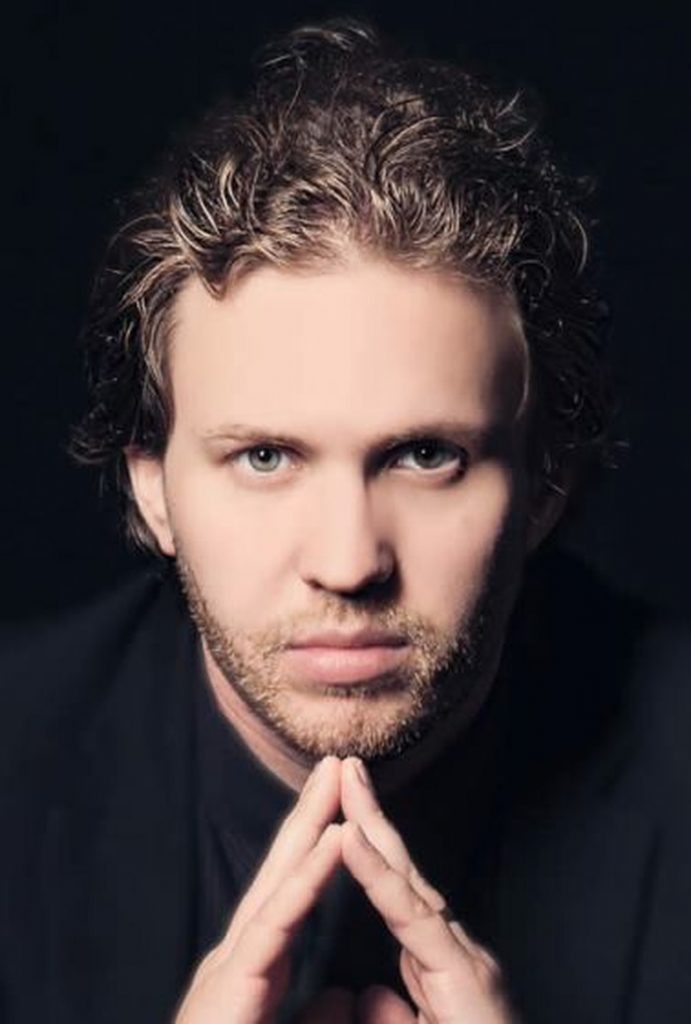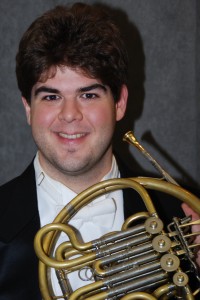David Danzmayr Serves Stirring Sibelius and Benjamin Jaber Celebrates John Williams’ Horn Concerto
Even if you were not a fan of the music of Jean Sibelius, it would have been difficult to resist the San Diego Symphony’s majestic and impassioned accounts of two of his greatest works, “Finlandia” and the First Symphony, Saturday at the Jacobs Music Center. Under the baton of guest conductor David Danzmayr, the orchestra unleashed the fiery dramatic outbursts of the patriotic “Finlandia” and traversed the rugged contours of his First Symphony with heroic confidence.

David Danzmayr [photo courtesy of the artist]
Since Danzmayr’s first appearance with the San Diego Symphony in 2016, the young Austrian has cultivated an enviable rapport with the San Diego players over subsequent visits, and on Saturday they gave him everything he requested and more. The bright tempos and orchestral verve he commanded from “Finlandia” easily foretold the smashing success he would have with the First Symphony.
Like Danzmayr’s inspired interpretation of Tchaikovsky’s First Piano Concerto with pianist Conrad Tao last November, Danzmayr’s taut, incisive direction of Sibelius’ roiling late Romantic Symphony No. 1 in E Minor riveted our attention from its mysterious opening clarinet solo to its blazing, brass-fueled final cadence.
Pacing proved to be Danzmayr’s key to success with this symphony, maintaining Sibelius’ sense of urgency throughout—even in the muted sections of the Andante—while patiently building each interior climax to a satisfying fruition. For a concert violinist manqué, Sibelius certainly knew how to deploy woodwinds eloquently, notably the first movement’s solo clarinet introduction, deftly illuminated by Principal Clarinet Sheryl Renk over hushed rolling timpani, and the flutes’ capricious second theme, as well as the Scherzo’s jewel-like woodwind Trio. But he did give the first violin captivating solos in the first movement, which Concertmaster Jeff Thayer turned out with authoritative finesse.
The orchestra’s strings projected robust sonorities, nobly propelling the composer’s resplendent, arching themes. Kudos to the brass choirs for their solid ensemble work and timbral choices: aptly dark, brooding colors early in the symphony and captivating brilliance at the finale. And for his unceasing stellar work throughout all four movements of the First Symphony, Principal Timpani Ryan DiLisi deserved at least time-and-a-half.
In the last decade I recall the orchestra performing two major concertos by John Williams, a Cello Concerto and a Bassoon Concerto, and this Horn Concerto proved equally impressive. Although each of its five movements sports a title that suggests a program, the work is superbly crafted and does not at all rely on these programmatic clues for its success.
Williams opens with Angelus, a deft melding of predictably soft bell themes from the tubular chimes into

Benjamin Jaber (photo courtesy of San Diego Symphony)
which the muted horn discreetly enters. Quickly the horn expands into more forceful fanfare motifs challenged by by astringent volleys from the string sections. After a period of jovial, astutely orchestrated clangor, the movement recedes to the faint texture of the first measures. Battle of the Trees pits a lively percussion section and pizzicato strings railing against rapid staccato horn themes.
Following this muscular encounter, for the Pastorale the composer has crafted an elegiac duet, launched gracefully by Principal Oboe Sarah Skuster and answered with equally nuanced phrasing by Jaber. Given the origin of the horn, composers have traditionally supplied a horn concerto with a movement built on volleys of hunting calls, and Williams obliged the tradition with Hunt, a movement full of unexpected twists as well as those immediately recognizable horn calls.
Having given the soloist ample chance to demonstrate his technical prowess throughout the concerto, Williams decided to end with a calmer finale, Nocturne, giving the soloist sumptuous but relaxed melodies to spin out, ending with the faint ring of the celesta and delicate farewells from the horn.
Throughout the concerto, Jaber summoned his most robust yet polished sonorities, skillfully crafting every phrase to complement its context. Danzmayr gave him unflagging support and sensitively shaped each movement. And although Williams’ style and technique exhibited nothing notably experimental, for a completely unfamiliar work, the Copley Symphony Hall audience received this performance with the ardent enthusiasm typically reserved for those chestnut Tchaikovsky and Rachmaninoff concertos.
This concert was presented by the San Diego Symphony on April 27, 2019, in the Jacobs Music Center’s Copley Symphony Hall in downtown San Diego and was repeated on April 28, 2019. The April 27th performance was attended for this review.

Ken Herman, a classically trained pianist and organist, has covered music for the San Diego Union, the Los Angeles Times’ San Diego Edition, and for sandiego.com. He has won numerous awards, including first place for Live Performance and Opera Reviews in the 2017, the 2018, and the 2019 Excellence in Journalism Awards competition held by the San Diego Press Club. A Chicago native, he came to San Diego to pursue a graduate degree and stayed.Read more…


